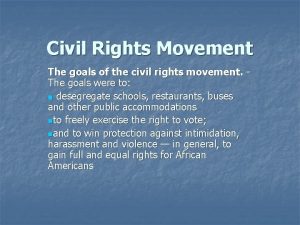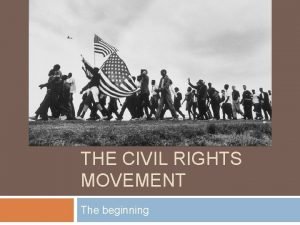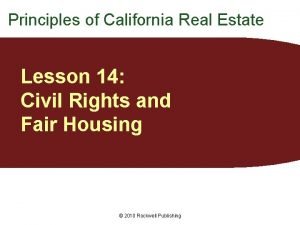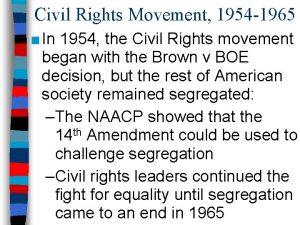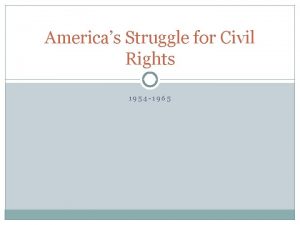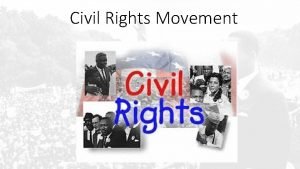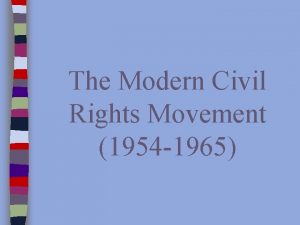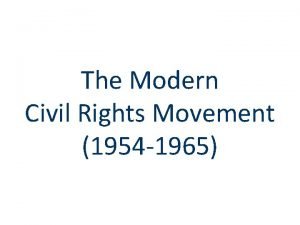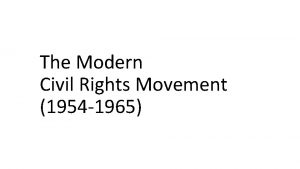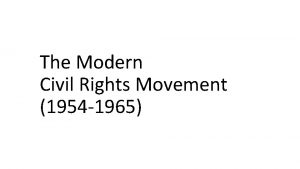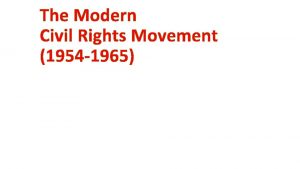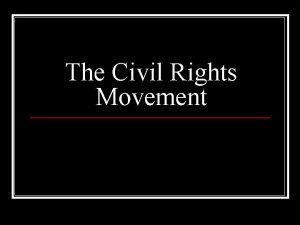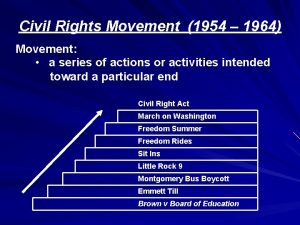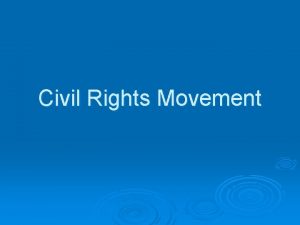Civil Rights Movement 1954 1965 Early Successes in













- Slides: 13

Civil Rights Movement (1954 -1965)

Early Successes in Civil Rights * 1950, the United States was a segregated society in the North and the South. – 1)Jim Crow laws throughout the South created a segregated society after the Civil War. – 2) “White flight” (Whites leaving inner-cities to the suburbs of northern cities left African. Americans (Black Americans) in the poorer inner cities.

Early Successes in Civil Rights st ■ In 1948, Truman became the 1 president to attack segregation: – Truman issued an executive order to integrate the military – He outlawed discrimination in the hiring of government employees ■ In 1947, Jackie Robinson was the 1 st black major league baseball player

Jackie Robinson signing his professional contract with Brooklyn Dodgers owner Branch Rickey in 1945 Robinsonmade won. National Rookie his MLB League of debut the Year MVP in 1947 inin 1947 1949

Brown v Board of Education (1954) – The Topeka, Kansas school district denied Linda Brown from attending a white school four blocks from her house. The father argued that besides having to take the daughter to a school farther away, it did not have adequate facilities or materials equal to the white school. – National Association for the Advancement of Colored People (NAACP) – NAACP’s lawyer, Thurgood Marshall, argued that even “equal” schools, if separate, imply that black children are inferior to whites.

■ The Supreme Court’s unanimous decision in Brown v Board of Education (1954) ruled “separate facilities are unequal” – Chief Justice Earl Warren stated that segregation violated 14 th Amendment. – The decision overturned the Plessy vs. Ferguson (1896) “separate but equal” policy.

Thurgood Marshall & his NAACP legal team Thurgood Marshall’s success in Brown made him the most famous black lawyer in the U. S. ; In 1967, he became the 1 st black justice appointed to the Supreme Court Linda Brown


– Schools integrated in Baltimore, St Louis, & Washington, D. C. – But Southern state leaders vowed to resist integration & the KKK led protests. – At first, President Eisenhower left enforcement of Brown up to states & did not enforce the decision.

Resistance to Brown “The people of Georgia will not comply with the decision of the court… We're going to do whatever is necessary in Georgia to keep white children in white schools and colored children in colored schools. "

Desegregating Schools ■ In 1957, President Eisenhower was forced to support integration – Arkansas governor Orval Faubus called the National Guard to keep black students from enrolling in Little Rock’s Central High School. – Eisenhower sent the Army to force integration for the black students, known as the “Little Rock Nine. ”

Integrating Central High School in Little Rock, Arkansas (1957) The “Little Rock Nine” Arkansas Governor Orval Faubus

Conclusions ■ The Brown v BOE decision was the first major step towards ending Jim Crow segregation in America. – Resistance to Brown revealed that civil rights leaders could not rely on the gov’t to protect rights. ■ New leaders would soon emerge to take charge of the movement
 Civil rights and civil liberties webquest
Civil rights and civil liberties webquest Goals of the civil rights movement
Goals of the civil rights movement Civil rights movement essential questions
Civil rights movement essential questions Civil rights movement vocabulary
Civil rights movement vocabulary Mother of the modern day civil rights movement
Mother of the modern day civil rights movement Civil rights movement webquest
Civil rights movement webquest Civil rights movement jeopardy
Civil rights movement jeopardy The civil rights movement
The civil rights movement Joseph stalin main accomplishments
Joseph stalin main accomplishments John cabot successes
John cabot successes Successes of reconstruction
Successes of reconstruction What did the civil rights act of 1875 do
What did the civil rights act of 1875 do Civil rights training quiz answers
Civil rights training quiz answers Unruh civil rights act real estate
Unruh civil rights act real estate

